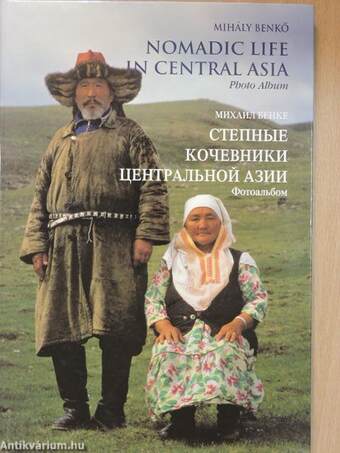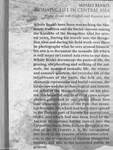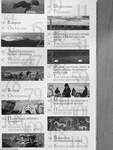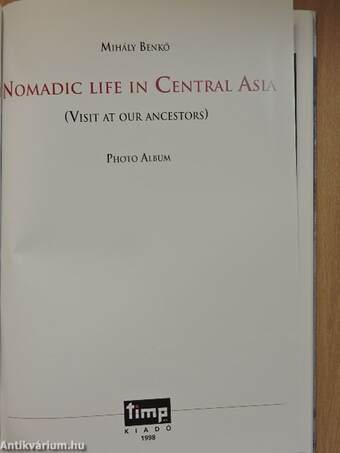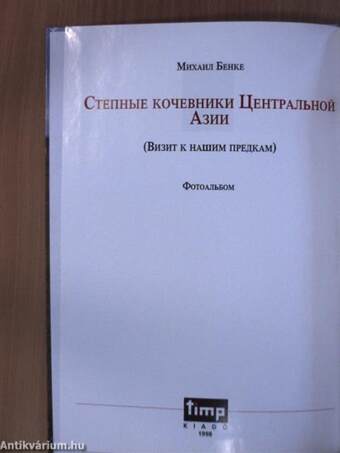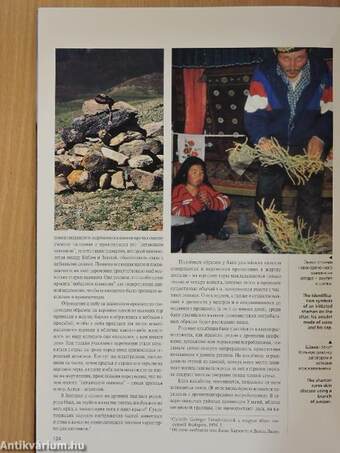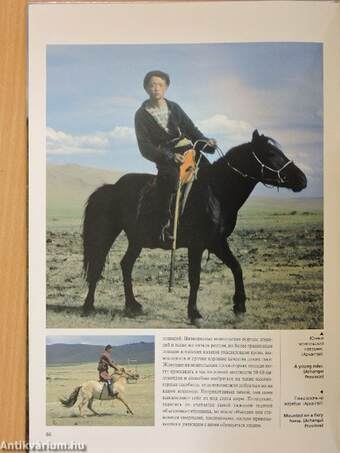1.066.237
kiadvánnyal nyújtjuk Magyarország legnagyobb antikvár könyv-kínálatát

VISSZA
A TETEJÉRE
JAVASLATOKÉszre-
vételek
Nomadic Life in Central Asia
(Visit at our Ancestors)/Photo Album
| Kiadó: | Timp Kft. |
|---|---|
| Kiadás helye: | Budapest |
| Kiadás éve: | |
| Kötés típusa: | Fűzött kemény papírkötés |
| Oldalszám: | 131 oldal |
| Sorozatcím: | |
| Kötetszám: | |
| Nyelv: | Angol Orosz |
| Méret: | 28 cm x 20 cm |
| ISBN: | 963-03-5993-6 |
| Megjegyzés: | Színes fotókkal. |
naponta értesítjük a beérkező friss
kiadványokról
naponta értesítjük a beérkező friss
kiadványokról
Fülszöveg
MIHÁLY BEN KŐ:
NOMADIC LIFE IN CENTRAL ASIA
Photo album with English and Russian text
Mihály Benkő have been researching the Sha-
manic tradition and the burial customs among
the Kazakhs of the Mongolian Altai for seve-
ral years. During his travels into the Mongo-
lian Altai and during his field-work over there
he photographs what he sees around himself.
His aim is to document the nomadic life which
is still intact in Central Asia even in our days.
Mihály Benkő documents the pastoral life, the
grazing, shepherding and milking of the ani-
mals, the mounted nomadic life, the winter-
and summer quarters, the everyday life of the
inhabitants of the yurts, the folk art, the
shamanic ceremonies and burial customs, the
landscape and the archaeological and histori-
cal relics of the Mongolian Altai on his pho-
tos. His beautiful and in several cases unique
photos published in our photo album first
time illustrate a piece of our Past: that moun-
ted Nomadic life... Tovább
Fülszöveg
MIHÁLY BEN KŐ:
NOMADIC LIFE IN CENTRAL ASIA
Photo album with English and Russian text
Mihály Benkő have been researching the Sha-
manic tradition and the burial customs among
the Kazakhs of the Mongolian Altai for seve-
ral years. During his travels into the Mongo-
lian Altai and during his field-work over there
he photographs what he sees around himself.
His aim is to document the nomadic life which
is still intact in Central Asia even in our days.
Mihály Benkő documents the pastoral life, the
grazing, shepherding and milking of the ani-
mals, the mounted nomadic life, the winter-
and summer quarters, the everyday life of the
inhabitants of the yurts, the folk art, the
shamanic ceremonies and burial customs, the
landscape and the archaeological and histori-
cal relics of the Mongolian Altai on his pho-
tos. His beautiful and in several cases unique
photos published in our photo album first
time illustrate a piece of our Past: that moun-
ted Nomadic life which had been once spread
in the Eastern part of Eurasia for several cen-
turies, and which had also been lived by the
Ancient Hungarians having arrived into the
Carpathian Basin from Eastern direction at the
end of the EX Century A. D. We recommend
this book to the experts of Orientalist scien-
ces, to the researchers of Ancient Hungarian
history, and also to the interested public in
general. Vissza
Témakörök
- Idegennyelv > Idegennyelvű könyvek > Többnyelvű könyvek
- Művelődéstörténet > Kultúra > Kultúrantropológia
- Néprajz > Folklór (szellemi néprajz) > Népi kultúrák > Ázsia
- Útleírás > Idegennyelvű útleírás > Egyéb
- Útleírás > Kontinensek > Ázsia > Belső-Ázsia
- Útleírás > Más népek
- Néprajz > Tárgyi néprajz > Egyéb
- Művészetek > Fotóművészet > Albumok > Külföldi
- Művészetek > Fotóművészet > Albumok > Tematikus
- Művészetek > Fotóművészet > Idegen nyelv > Többnyelvű
- Művészetek > Fotóművészet > Témái > Egyéb
Benkő Mihály
Benkő Mihály műveinek az Antikvarium.hu-n kapható vagy előjegyezhető listáját itt tekintheti meg: Benkő Mihály könyvek, művekMegvásárolható példányok
Nincs megvásárolható példány
A könyv összes megrendelhető példánya elfogyott. Ha kívánja, előjegyezheti a könyvet, és amint a könyv egy újabb példánya elérhető lesz, értesítjük.



